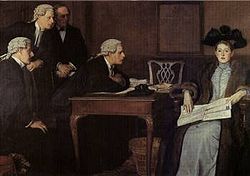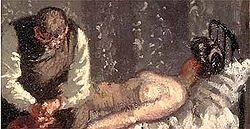
Problem picture
Encyclopedia

Genre
Genre , Greek: genos, γένος) is the term for any category of literature or other forms of art or culture, e.g. music, and in general, any type of discourse, whether written or spoken, audial or visual, based on some set of stylistic criteria. Genres are formed by conventions that change over time...
of art popular in the late Victorian era
Victorian era
The Victorian era of British history was the period of Queen Victoria's reign from 20 June 1837 until her death on 22 January 1901. It was a long period of peace, prosperity, refined sensibilities and national self-confidence...
, characterised by a deliberately ambiguous narrative that can be interpreted in several different ways, or which portrays an unresolved dilemma. It is the pictorial equivalent of the problem play
Problem play
The problem play is a form of drama that emerged during the 19th century as part of the wider movement of realism in the arts. It deals with contentious social issues through debates between the characters on stage, who typically represent conflicting points of view within a realistic social...
. The viewer of the picture is invited to speculate about several different possible explanations of the scene.
The genre began to emerge in the second half of the nineteenth century, along with the development of book illustrations that depicted "pregnant" moments in a narrative. One of the earliest problem pictures is John Everett Millais
John Everett Millais
Sir John Everett Millais, 1st Baronet, PRA was an English painter and illustrator and one of the founders of the Pre-Raphaelite Brotherhood.-Early life:...
' Trust Me, which depicts an older man demanding that a young woman hand him a letter she has received. Either character might be uttering the words. The significance and content of the letter is left to the imagination. Their relationship is also unclear; in view of their ages, they might be a married couple, or a father and daughter. Other artists who worked in the genre included William Frederick Yeames
William Frederick Yeames
William Frederick Yeames was a British painter best known for his oil-on-canvas problem picture And When Did You Last See Your Father?, which depicts the son of a Royalist being questioned by Parliamentarians during the English Civil War.-Biography:Yeames was born in Taganrog, Russia, the son of a...
, whose "And when did you last see your father?" became the most famous example of the genre. It depicts a young boy of the English civil war
English Civil War
The English Civil War was a series of armed conflicts and political machinations between Parliamentarians and Royalists...
period being gently interrogated by Cromwellian
Oliver Cromwell
Oliver Cromwell was an English military and political leader who overthrew the English monarchy and temporarily turned England into a republican Commonwealth, and served as Lord Protector of England, Scotland, and Ireland....
troops who are looking for his Royalist father. It is implied that they are asking a trick question designed to discover his location. The painting is poised at the moment the child is about to answer. Yeames painted many other works of this type, including Amy Robsart and Defendant and Counsel. When the latter was exhibited a newspaper ran a competition for readers to guess what crime the woman was accused of.

Edgar Degas
Edgar Degas[p] , born Hilaire-Germain-Edgar De Gas, was a French artist famous for his work in painting, sculpture, printmaking and drawing. He is regarded as one of the founders of Impressionism although he rejected the term, and preferred to be called a realist...
and his follower Walter Sickert
Walter Sickert
Walter Richard Sickert , born in Munich, Germany, was a painter who was a member of the Camden Town Group in London. He was an important influence on distinctively British styles of avant-garde art in the 20th century....
. Degas's Interior
Interior (Degas)
Interior , also known as The Rape , is an oil painting on canvas by Edgar Degas , painted in 1868–1869. Described as "the most puzzling of Degas's major works", it depicts a tense confrontation by lamplight between a man and a partially undressed woman...
(1869) depicts an ambiguous scene suggestive of sexual transgression and violence (hence the alternative title of "the Rape"). Similar ambiguity is found in Sickert's The Camden Town Murder
The Camden Town Murder
The Camden Town Murder is a title given to a group of four paintings by Walter Sickert painted in 1908. The paintings have specific titles, such as the problem picture What Shall We Do for the Rent or What Shall We Do to Pay the Rent....
(1908), in which the two figures can be interpreted as a couple, or a killer and his victim.
The genre continued to be popular into the early twentieth century, but was by this time increasingly seen as old fashioned and as literary, contrary to the emphasis on pictorial form characteristic of impressionism
Impressionism
Impressionism was a 19th-century art movement that originated with a group of Paris-based artists whose independent exhibitions brought them to prominence during the 1870s and 1880s...
and post-impressionism
Post-Impressionism
Post-Impressionism is the term coined by the British artist and art critic Roger Fry in 1910 to describe the development of French art since Manet. Fry used the term when he organized the 1910 exhibition Manet and Post-Impressionism...
.

